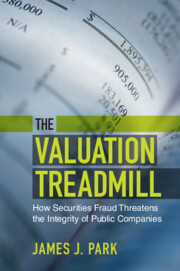Book contents
- The Valuation Treadmill
- The Valuation Treadmill
- Copyright page
- Dedication
- Contents
- Acknowledgments
- 1 Introduction
- 2 Xerox and the Pressure to Meet Projections
- 3 Penn Central and the Decline of Managerialism
- 4 Apple and the Controversy of Projections Litigation
- 5 Enron and Sarbanes–Oxley
- 6 Citigroup and the Financial Crisis of 2008
- 7 General Electric and the Problem of Earnings Management
- 8 The Future of Securities Fraud Regulation
- 9 Conclusion
- Notes
- Index
6 - Citigroup and the Financial Crisis of 2008
Published online by Cambridge University Press: 14 July 2022
- The Valuation Treadmill
- The Valuation Treadmill
- Copyright page
- Dedication
- Contents
- Acknowledgments
- 1 Introduction
- 2 Xerox and the Pressure to Meet Projections
- 3 Penn Central and the Decline of Managerialism
- 4 Apple and the Controversy of Projections Litigation
- 5 Enron and Sarbanes–Oxley
- 6 Citigroup and the Financial Crisis of 2008
- 7 General Electric and the Problem of Earnings Management
- 8 The Future of Securities Fraud Regulation
- 9 Conclusion
- Notes
- Index
Summary
What does solvent mean? JP Morgan CEO Jamie Dimon, 2010 A little more than five years after the passage of the Sarbanes–Oxley Act of 2002 (Sarbanes–Oxley),1 many of the nation’s largest financial institutions failed or were pushed to the brink of failure. An unprecedented decline in housing prices reduced the value of securities backed by housing loans owned by many banks. The resulting insolvency of some of the most significant Wall Street giants prompted the worst financial turmoil since the Great Depression. The crisis raised serious questions about the efficiency of markets as hundreds of billions of dollars in market capitalization suddenly disappeared. The losses suffered by investors were more severe and long lasting than those that came out of the market crisis that helped give rise to Sarbanes–Oxley.
Keywords
- Type
- Chapter
- Information
- The Valuation TreadmillHow Securities Fraud Threatens the Integrity of Public Companies, pp. 95 - 113Publisher: Cambridge University PressPrint publication year: 2022

